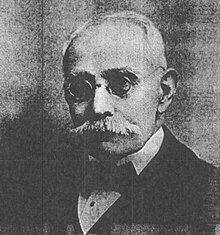Cipriano Ferrandini
This article relies largely or entirely on a single source. (October 2011) |
Cypriano Ferrandini | |
|---|---|
 Cypriano Ferrandini | |
| Born | 1823 |
| Died | December 20, 1910 (aged 86–87) Baltimore, Maryland, U.S. |
| Resting place | Saint Mary Catholic Cemetery, Baltimore |
| Occupation(s) | Barber, Southern sympathizer, alleged conspirator |
Cypriano Ferrandini (1823 – December 20, 1910) was a barber from Corsica who emigrated to the United States, and established himself as the long-time barber and hairdresser in the basement of Barnum's Hotel, in Baltimore, Maryland. There he practiced his trade from the mid-1850s to his retirement long after the close of the Civil War. He was accused of, but never indicted for, plotting to assassinate U.S. President-elect Abraham Lincoln on February 23, 1861. While once caught in a secessionist dragnet in 1862, he was never prosecuted for his pro-Southern convictions and membership in the Knights of the Golden Circle.[1]
On the nights of February 21 and 22, 1861, Allan Pinkerton and Frederick Seward warned Lincoln that he ought not to appear in public in Baltimore as scheduled because plans were afoot to assassinate him. Lincoln chose to heed the warning, donned a disguise of a soft cap, and passed through Baltimore unseen and unheralded on the night of the 22nd, leaving Mrs. Lincoln and the children to face the crowd awaiting his arrival from Harrisburg the following day, February 23, 1861.[2]


Role in alleged conspiracy
[edit]There is disagreement among historians as to whether a plot to assassinate Lincoln in Baltimore actually existed and Ferrandini's role in such a plot. John Thomas Scharf argued that there was no credible evidence of a plot and no one was ever arrested for even contemplating one, although many other citizens were thrown into jail without benefit of habeas corpus while William Evitts, in A Matter of Allegiances, argued in favor of there being such a plot based on the papers of Allan Pinkerton which The Huntington Library acquired, and which Norma B. Cuthbert edited for publication in 1949.
The only purported contemporary account of Pinkerton is the transcript of his 1861 journal. Pinkerton's account relies upon one agent and two sources to document Cypriano Ferrandini as the leader of the assassination plot. His agent met with Cypriano and reported the extent of the plot. In Spy of the Rebellion (1883),[3] Pinkerton asserts that in addition to his spy Howard, he also met with Captain Ferrandini (whom he calls Fernandina), at Guy's Monument Hotel. At Guy's, Pinkerton reports that "Fernandina cordially grasped my hand, and we all retired to a private saloon, where after ordering the necessary drinks and cigars, the conversation" turned to the assassination and Ferrandini was asked "Are there no other means of saving the South except by assassination?" "No replied Fernandina, ... He must die – and die he shall, And, ... if necessary, we will die together." To illustrate his story, Pinkerton included a drawing of himself seated at a table with Ferrandini standing, hand upraised as if clutching a dagger.[3] Pinkerton later began to doubt Ferrandi's boast.[citation needed]

Eighteen days before the alleged timing of the terrorist attack on Lincoln, Cypriano Ferrandini appeared before a Congressional Committee investigating rumors that efforts would be made to prevent the President-elect from reaching his inaugural, or if he did manage to get to Washington, seriously disrupt the ceremonies. The committee had been formed at the end of January when the Union appeared to be rapidly dissolving. Ferrandini told the committee the following February that he made his secessionists views very clear and had no problems admitting that he was engaged in applying his military training to a group dedicated to preventing the "Northern Volunteers" from passing through Maryland.
See also
[edit]- Baltimore Plot
- American Civil War spies
- Allan Pinkerton
- John Wilkes Booth
- Ward Hill Lamon
- George Proctor Kane
- Hattie Lawton
Notes
[edit]- Cuthbert, Norma Barrett (ed.). Lincoln and the Baltimore Plot, 1861. (1949). Note that the factual content of this entry is based upon the on line biography by Dr. Edward C. Papenfuse at the Maryland State Archives web site: http://www.msa.md.gov/megafile/msa/speccol/sc3500/sc3520/014400/014473/html/14473bio.html.
- Evitts, William J., A Matter of Allegiances- Maryland from 1850-1861(Baltimore: Johns Hopkins University Press,1974). Professor Evitts assessment of Ferrandini has been strengthened by Michael J. Kline, The Baltimore Plot. The First Conspiracy to Assassinate Abraham Lincoln (Yardley, Pennsylvania: Westholme Publishing, LLC, 2008).
- Pinkerton, A. (1883). The Spy of the Rebellion; being a true history of the spy system of the United States Army during the late rebellion. Revealing many secrets of the war hitherto not made public. Comp. from official reports prepared for President Lincoln, General McClellan and the provost-marshal-general. New York, G.W. Carleton & Co.
- United States. Congress. House. Select committee of five, appointed January 9, 1861 (1865). See: https://archive.org/details/allegedhostileor00unit
References
[edit]- ^ Keehn, David (2013). Knights of the Golden Circle : Secret Empire, Southern Secession, Civil War. LSU Press. p. 24.
- ^ Daniel Stashower, "The Unsuccessful Plot to Kill Abraham Lincoln " Archived 2013-12-06 at the Wayback Machine, Smithsonian magazine, February 2013. Retrieved February 6, 2013.
- ^ a b Pinkerton, Alan (1885). The Spy of the Rebellion. Hartford, CT.: M. A. Winter and Hatch. pp. 64–65.
spy of the rebellion.
- 1823 births
- 1910 deaths
- 19th-century American people
- American people of Corsican descent
- French emigrants to the United States
- People from Corsica
- Lincoln assassination conspirators
- Failed assassins of presidents of the United States
- Baltimore Plot
- People of Maryland in the American Civil War
- American failed assassins
- People from Baltimore
